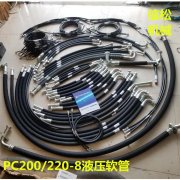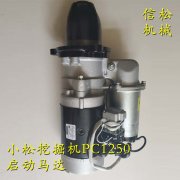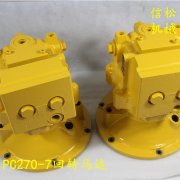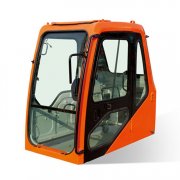Mob:13455586850
Tel:13475776188
Email:jnxinsong@163.com
Add:B4-108, meiheng Construction Machinery City, West Outer Ring Road, Rencheng District, Jining City, Shandong Province
At present, the hydraulic hose joints on the market mainly include threaded connection, flange connection, quick connector connection and other types. Different types have different purposes. The main parts of the hydraulic hose are made of stainless steel, which ensures the good temperature resistance and corrosion resistance of the hydraulic hose. Moreover, there are many types of hydraulic hose joints, Specifications are mainly based on the size of the inner diameter to select the appropriate products. The breakage of hydraulic hose is usually not caused by very little apparent pressure, or it is related to the intensity of pressure influence and times. During the operation of construction machinery, the sudden increase or decrease of oil pressure will occur repeatedly in the oil pipe, which will form a severe pressure impact on the hydraulic hose, resulting in the damage and intensification of the oil seal of each part, the blistering and rupture of the rubber hose and the loosening and leakage of the pipe plug. Therefore, in manual operation, the pulling of the valve rod should not be so fierce, and it should be flat. When installing the hydraulic hose, if the pressure is too large, or the plug and hose are too loose, the hose may come out of the joint at the end of use under the action of oil pressure; If the crimping amount is too small and the plug and rubber hose are pressed so tightly, it is not easy to cause local damage to the inner layer of the rubber hose, resulting in cracks. The high-pressure oil will indirectly transfer into the steel wire layer from the fracture, and then flow to the tail of the jacket along the gap between the steel wires, or always accumulate somewhere along the steel wire layer, causing bulge and fracture of the outer rubber. Characteristics and classification of hydraulic hose. The hydraulic hose is mainly made of stainless steel and has high corrosion resistance. The working temperature range of hydraulic hose is wide, ranging from - 196 to 600 ℃, with good high and low temperature resistance. The hydraulic hose body is hydraulically formed, with good flexibility, good flexibility, strong bending and seismic capacity, bending resistance, tensile resistance, lateral pressure resistance and so on. The hydraulic hose has good wear resistance, can prevent rat bite, and can protect the internal wires from damage. There are many types of high-pressure water cleaning joints. Appropriate joints should be selected, and the joint sleeve design should be standard and reasonable. Sharp grooves and irregular dimensions will break the steel wire reinforcement layer. When crimping the joint, the amount of crimping shall be determined according to the inner diameter and outer diameter of the hose. The hydraulic hose is equipped with many joints, which is easy to connect with other equipment. Both ends of the hose can also be made into other connection methods other than threads, also known as flanges, flanges or flanges, which is convenient to connect and use with other equipment. The hydraulic hose is easy to thread, install and locate, which is not only suitable for matching with the rotary joint, but also widely used in the soft connection of the transportation of a variety of fluid media (decisive substances). What are the classifications of hydraulic hoses? Threading hydraulic hoses: threading hydraulic hoses are mainly made of stainless steel, with excellent flexibility, corrosion resistance and tensile resistance, high temperature resistance and wear resistance (a basic type of parts failure). They are mainly used as maintenance tubes for wires and cables. The hydraulic hose connector is made of high-quality carbon steel or stainless steel, and advanced crimping equipment and technology are adopted. Ultra high pressure hose is also widely used in our daily life. Corrugated hydraulic hose: corrugated hydraulic hose is mainly composed of corrugated pipe, mesh sleeve and joint. Corrugated pipe plays a flexible effect in corrugated hydraulic hose. It is made of thin-walled stainless steel with spiral or annular waveform. The mesh sleeve is woven by hydraulic wires or hydraulic belts interspersed with each other in a certain order. It is installed on the outer surface of the hydraulic bellows and has the effect of strengthening and shielding. The structural methods of joints are generally divided into three categories: screw type, flange type and quick type. For different application requirements, the connection methods between bellows, mesh sleeve and joint include welding type, mechanical clamping type and hybrid type. Plastic coated hydraulic hose: plastic coated hydraulic hose is a new type of hose. Its inner layer is specially treated with stainless steel hose or galvanized hose, and its outer layer is made of PVC material, which has the characteristics of anti ultraviolet and anti-aging....

The starting motor is generally composed of transmission mechanism, control mechanism (electromagnetic switch) and DC motor. The working principle of the starting motor is to convert the electric energy of the battery into mechanical energy, so as to drive the flywheel on the engine to rotate, so as to realize the starting of the engine. DC motor produces electromagnetic torque, that is, DC motor is responsible for rotation. The transmission mechanism engages the gear driven by the starting motor into the flywheel ring gear, transmits the torque on the DC motor of the starting motor to the engine flywheel, drives the engine crankshaft to rotate, and drives all parts of the engine to work cycle until the engine starts. After the engine starts, make the starter automatically disengage the ring gear. The electromagnetic switch is responsible for connecting and cutting off the circuit between the DC motor and the battery. According to the control mechanism, the starting motor can be divided into direct control type and electromagnetic control type. Now most of our common starting motors are electromagnetic control type. The starting time of the starting motor shall not be too long. Generally speaking, it is best to start the motor in about 10 seconds. The time interval between two starts of the starting motor is about 1 minute, preferably greater than 1 minute. If it cannot be started for three consecutive times, check the engine, battery, circuit line and wiring point. For the starting motor without overcurrent protection device, if it cannot be started for three consecutive times, stop the starting motor at this time, because the starting current is too large and works for a long time. At this time, the starting motor will overheat due to excessive current. If you continue to forcibly start the motor, the motor is likely to burn out. After replacing the starting motor, pay attention to the contact points of the positive and negative lines. It is best to polish the contact points and install them firmly, otherwise the engine will not start when the engine is hot. The maintenance of the starting motor should have a good starting habit. Generally, the starting time should not exceed 5 seconds. It can be started after more than 15 seconds of continuous starting time. It can not be started normally for the third time, and it can be started after one minute. Do not start continuously for too long to avoid burning the starter (i.e. motor). Check the battery regularly so that the battery can start the engine at normal capacity and power. Car starting batteries are maintenance free, and their service life is between one and a half to two years. The service life depends on the frequency of the owner's use of the car. At a certain time, you must go to a professional maintenance point for inspection. Clean the engine compartment regularly to prevent dust and oil and water from corroding and aging the engine compartment harness, so that the starter interface can not be contacted or rusted, and the poor conductivity affects the normal start of the engine. It is not necessary under normal circumstances. If you feel that the starter has teeth and weak start, go to the maintenance shop for maintenance....

The slewing mechanism of excavator is a special working system to ensure the 360 degree rotation of the cockpit. The slewing mechanism of excavator includes slewing motor, slewing drive and slewing control. The rotation time of the rotary mechanism accounts for about 50-70% of the whole working cycle time, the energy consumption accounts for about 25-40%, and the calorific value of the rotary hydraulic oil circuit accounts for about 30-40% of the total calorific value of the hydraulic system. The basic requirement of slewing mechanism is to shorten the slewing period as much as possible on the premise that the slewing torque and acceleration do not exceed the allowable value. Xinsong introduces the key parts of the rotary motor. The rotary motor is the key part of the rotary mechanism, which converts the oil pressure provided by the main pump into mechanical energy to input into the gearbox. Its working performance will directly affect the speed, driving torque, rotary parking and parking brake of the whole machine, which is the key to determine the productivity of the whole machine. Rotating motor is divided into low-speed high torque motor and high-speed rotating motor. In the slewing mechanism of modern excavator, low-speed high torque motor is rarely used because of its large volume and heavy weight, while high-speed slewing motor is widely used because of its small volume and light weight, which is convenient for the reasonable layout of slewing mechanism and can meet the requirements of different slewing speeds and torques. After working for a long time, the rotary motor of rotary mechanism of excavator often appears the phenomenon of weak rotation and unstable rotation. The reasons and countermeasures will not be mentioned for the time being and will be discussed next time. The parts of the rotating horse include: rotating parts, which are composed of cylinder body, plunger, slipper, pressing plate and output shaft. The brake component is composed of rotary brake control valve, pressure plate, friction plate, brake piston and brake spring. The relief valve is composed of relief valve and one-way valve. The working principle of the rotary motor is that the hydraulic oil of the oil pump enters into different oil passages to push different plungers, slippers, swash plates, etc. to realize left and right rotation. The safety valve (safety valve) in the rotary motor is installed on the top of the rotary motor. It limits the pressure of the rotary circuit within the set safety pressure range, and reduces the impact when the rotary motor starts or stops. The safety valve is a two-stage design. When the safety valve is opened, there is no excessive pressure, so when the rotating motor stops, there is almost no vibration load. The function of the slow check valve is to supplement the oil lost in the process of stopping the rotary action. In the process of stopping or decelerating rotation, due to the sudden disappearance and reduction of working hydraulic oil, the rotary motor is easy to produce vacuum. Therefore, the whole system needs to be specially designed to avoid the damage of vacuum to the motor. As the key component of hydraulic excavator, the performance and quality of rotary motor are directly related to the production efficiency of excavator. The choice of accessories is crucial. The following is about the abnormal noise of the rotary motor. The abnormal noise of the rotating motor mainly comes from two aspects: the abnormal noise of the rotating motor is mainly due to the damage or abnormal wear of the internal parts, resulting in the sealing surface can not seal oil normally. When the excavator stops, it will make a squeak and rotate slowly. The countermeasures are the same as those for the inner leakage parts. The worn parts and the damaged and invalid seals should be replaced. Rotating motor brake, rotating motor oil filling check valve, buffer safety valve and other faults. Before the rotary motor rotates, the braking effect of the rotary brake must be released. If the slewing brake fails, it can't absorb the impact or release the brake completely, which will cause abnormal sound of the slewing motor. The oil filling function of the check valve can prevent suction. Once blocked, there will be suction phenomenon, causing abnormal sound. If the buffer safety valve controlling the rotary motor is damaged, there will be abnormal noise when the rotary motor rotates left and right and stops. The countermeasures are to check whether the overflow valve and oil filling check valve work normally and whether the design of oil filling circuit is reasonable....

Excavator cab must be ventilated, but we also know that the working environment of the excavator is relatively bad, so if the ventilation measures are not good, it may bring some harm to the driver. So, what measures should be taken for excavator cab ventilation? Now let's take a look at the introduction of professional manufacturers. Excavator cab ventilation adopts natural ventilation mode, which is the air pressure difference caused by the relative movement of vehicles in the process of driving or working. When the excavator cab works at low speed or fixed position, especially in the case of large dust, it is not suitable to adopt the natural ventilation measures based on the air pressure difference caused by speed. Forced ventilation is the use of fans to send fresh air into the room, which needs energy and equipment. The cab of fully enclosed excavator equipped with heating and cooling equipment usually adopts the combined device of ventilation, heating and cooling. What should be paid attention to in front window design of excavator cab? The parameters of the movable front window influence each other. The design parameters should be determined in the order of important, secondary and unimportant, and then fine tuned. By increasing the slope of the lower guide rail, increasing the height of P point and moving the position of o point forward, the rebound phenomenon of the sealing rubber can be reduced or avoided. The strength of gas spring should be selected correctly, and the movable window should provide appropriate pressure when opening and closing. The windows shall be designed with special structure to balance the stress at both ends. The double spring structure should ensure that the two springs exert the same force at the same time, reduce the weight of the movable window frame as far as possible, and improve its torsional strength. Small manufacturing or assembly error will lead to large deviation of key points, so the subsequent assembly compensation of key point error should be considered in the design stage. The cab vibration of construction machinery excavator is abnormal. First, check whether the shock absorbers at the four corners of the cab are loose. When the shock absorber screw is loose, the vibration of the cab is abnormal, especially when the engine speed is high, the shaking of the cab and the surrounding glass is particularly obvious. Therefore, the vibration can be eliminated by tightening the screws of the shock absorber. Boom shaking is mainly the sound of the cylinder. At this time, check the boom check valve for wear. If so, when the hydraulic oil is delivered to the boom cylinder through the valve core, the action will be incoherent, and the amplitude of the boom will increase with the increase of the action frequency. When there is a hook sound in the rotating parts, there will be slight vibration in the cab, which is caused by impurities between gears or gear fracture. When rotating to a fixed position, abnormal vibration occurs, indicating that the rotating motor vibrates. It is recommended to check the gear oil and grease for impurities or iron filings. First, check whether the main pressure is normal and whether it matches the engine power. The two output oil pipes of the second hydraulic pump shake, check whether the regulator sends out, and check whether the safety lock solenoid valve switch is in place. Check whether there is metal powder in the hydraulic oil tank and oil return filter element, and judge the wear condition of plunger. Three pilot oil pipes shake, check whether the pilot filter element and the connection with the filter screen are blocked, and clean them with diesel regularly. First, check the four engine gaskets for damage. If so, the vibration of the engine will be very obvious. Solution: replace the machine foot pad to ensure the engine balance. When the second engine starts to shake, check the cylinder block for failure. After the temperature drops, you can touch the place where the high-pressure oil enters the cylinder block to see if there is a temperature difference. Reconfirm whether the injector and piston ring are worn. If the above two components are damaged, the injection time and injection volume are inconsistent, which will also cause jitter....

The rotary motor of Komatsu excavator is the key component of the rotary mechanism, which can convert the oil pressure provided by the main pump into mechanical energy and input it to the gearbox. Its working performance will directly affect the rotary speed, driving torque, rotary parking and parking brake of the whole machine, which is the key to determine the productivity of the whole machine. Rotary motor is divided into low speed high torque motor and high speed rotary motor. Low speed and high torque motor is seldom used in the slewing mechanism of modern excavators because of its large volume and heavy weight, while high speed slewing motor is widely used because of its small volume and light weight, which is convenient for the reasonable layout of slewing mechanism and can meet the requirements of different slewing speeds and torques. The rotary motor consists of a cylinder body, a plunger, a slipper, a pressure plate and an output shaft, a brake assembly, a rotary brake control valve, a pressure plate, a friction plate, a brake piston and a brake spring, an overflow valve and an oil supplement valve, and a rotary damping valve composed of an overflow valve and a one-way valve. Excavator rotary motor fault and troubleshooting, rotary relief valve (safety relief valve), generally in the rotary motor valve cover two protruding one-way valves, rotary normal work, the valve closed, only when the load exceeds the specified limit (system pressure exceeds the set pressure) open overflow, overload protection, so that the rotary pressure does not increase, It plays the role of protecting the rotary motor. When there is a fault, it is fast while slow, or the speed is too slow. The delay valve is also called brake valve or parking brake valve (some manufacturers have rotary brake solenoid valve). As the name suggests, it controls the brake. If the machine needs to stop during driving, the weight of the machine may cause unconscious sliding. Connecting the delay valve (brake valve) can prevent the machine from unconscious sliding. In general, it is the extra square of the rotary motor. When there is a fault, there will be no rotation, or very slow, or slow for a while. At this time, the delay valve can be removed for cleaning, which can generally solve the problem. Dirty hydraulic oil can also cause this fault. The make-up valve (make-up valve) protects the rotary motor by providing return oil to the rotary motor to prevent cavitation in the rotary motor. The fault phenomenon is slow acceleration and slow speed. Plunger, valve plate and brake pad are the main internal components of rotary motor, and also the main power source of rotary motor. The fault phenomenon is that the clearance between plunger and cylinder plug hole is increased, resulting in serious clearance leakage. The plunger needs to be replaced. The return spring is fatigued and the elastic force decreases, which leads to the collusion of the high and low pressure oil circuits of the cylinder block. The spring needs to be replaced. The wear of slipper and plunger accelerates the dry sliding friction between slipper and bearing plate, resulting in the increase of rotary resistance. It needs to be repaired or replaced. The slewing motor bearing is damaged, and the bearing cannot be positioned. It is necessary to replace the bearing of specified model. The oil distribution surface of valve plate and cylinder block is worn, resulting in internal leakage and weak rotation. It needs to be repaired or replaced. The aging failure of parking brake pad leads to the brake can not be completely released and the turning resistance increases. The sealing element must be replaced. Adjust the oil discharge steps of the rotary motor to make the upper rotary platform rotate. Check the performance of the rotary motor by measuring the oil discharge amount at this time. When measuring, we should not only ensure the safety of the surveyors, but also pay attention to the surrounding safety. The oil displacement of the rotary motor is greatly affected by the oil temperature, so please keep a certain oil temperature. Set the hydraulic oil temperature to 50 ± five ° C(122 ± nine ° F)。 Make the rotary motor run and preheat the inside of the motor. Shut down the engine and press the exhaust valve of the oil supply cap to exhaust the air in the hydraulic tank. Remove the oil drain hose on the oil drain port of the rotary motor from the side of the rotary motor, and install the cock (9 / 16-18unf) onto the removed oil drain hose. Install the measuring oil drain hose on the side of the rotary motor....

Copyright © 2021-2023 Jining Xinsong Construction Machinery Co., Ltd. all rights reserved Record No:鲁ICP备16023215号-1